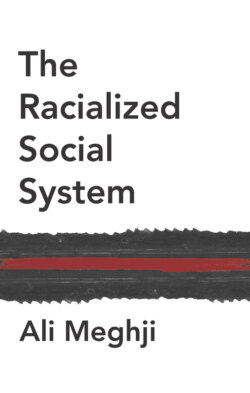Читать книгу The Racialized Social System - Ali Meghji - Страница 15
Chapter overviews
ОглавлениеIn the first chapter, ‘The Racialized Social System and Social Space: Racial Interests and Contestation’, I define the racialized social system in depth. In particular, I look at how the racialized social system involves the construction of race and unequal distribution of resources across this racial hierarchy. I then pay attention to how differently racialized actors develop racial interests to either preserve or challenge the racial order, and how the racialized social system therefore becomes a site of perpetuating contestation. In order to explore such phenomena, I take inspiration from Bourdieu’s theory of social space, essentially arguing that the racialized social system approach is a certain analysis of social space.
In the second chapter, ‘Racial Ideologies and Racialized Emotions: Seeing, Thinking and Feeling Race’, I look at the reproduction and articulation of the racialized social system at the micro level. Firstly, I pay attention to racial ideologies as the everyday frameworks people use to explain racial phenomena in a way that reproduces racism. I then connect such ideologies to racialized emotions – the emotional bonds that act as vehicles for the transmission of racial ideologies. I conclude this chapter by looking at three political projects – Trumpamerica, Brexit Britain and Bolsonaro’s Brazil – to demonstrate how emotions and ideologies come together in the reproduction of racism.
I stay with the micro in the third chapter, ‘Theorizing the Racialized Interaction Order’. In this chapter, I draw on interactionist sociology to show how the racialized social system necessarily entails a diffuse system of interactional risks, and interactional rights, and that such risks and rights are unequally distributed across the racial hierarchy. I therefore use this chapter to clarify how racial projects of segregation – such as Apartheid or Jim Crow – show very explicit interaction orders, with legally distributed interactional rights and risks. Further, I also focus on the contemporary to show how differently racialized people continue to be afforded different ‘legitimate’ interactional rights and risks, using examples such as that of Black professionals in the workplace.
In the fourth chapter, ‘Meso Racial Structures and Racialized Organizations’, I turn to the meso. This chapter homes in on recent scholarship on racialized organizations, paying specific attention to how such meso structures constrain the agency of people of colour, free up the agency of whites, and legitimate the unequal distribution of societal resources. I use case studies ranging from sport to the professional workplace and creative industries to highlight how studying organizations is a crucial way for us to understand the processes of racialization and racism.
I conclude in the final chapter, ‘What is Critical about Critical Race Theory?’ In this chapter, I try to look at the potential limitations of CRT and how various critical race theorists have therefore tried to stretch its conceptual apparatus. In particular, I look at the postcolonial challenge to CRT, questioning the extent to which CRT is able to engage in transnational, historical analysis, and the extent to which it practises methodological nationalism. Further, I also specify some key dimensions of contemporary social life that necessitate a CRT analysis – from the rise of ‘diversity training anti-racism’ through to ongoing climate crises and hierarchization of different ‘racisms’, therefore concluding that CRT may not be perfect, but it is indeed necessary.
